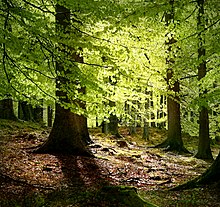
Back Kohlenwald German Forêt Charbonnière French Silva Carbonaria Italian シルウァ・カルボナリア Japanese Carbonaria silva Latin Kolenwoud Dutch Floresta Carbonária Portuguese

Silva Carbonaria, the "charcoal forest",[1] was the dense old-growth forest of beech and oak that formed a natural boundary during the Late Iron Age through Roman times into the Early Middle Ages across what is now western Wallonia. The Silva Carbonaria was a vast forest that stretched from the rivers Zenne and the Dijle in the north to the Sambre in the south.[2] Its northern outliers reached the then marshy site of modern Brussels.[3]
Further to the southeast, the higher elevation and deep river valleys were covered by the even less penetrable ancient Arduenna Silva, the deeply folded Ardennes, which are still partly forested to this day. To the east, the forested zone was possibly considered to extend to the Rhine. It was there in Cologne in 388 CE that the magistri militum praesentalis Nannienus and Quintinus[4] began a counter-attack against a Frankish incursion from across the Rhine, which was fought in the Silva Carbonaria.[5]
- ^ Or Carbonarius saltus, "the charcoal ravine or wildwood" — in the sense of "unfit for the plough" (Hoffmann 1698, s.v. "Carbonarius saltus"); the lexicographer Hoffmann found Carbonaria silva mentioned by Gregory of Tours, the twelfth-century chronicler Sigebert of Gembloux, and Johannes Trithemius.
- ^ F. L. Ganshof, "Manorial Organization in the Low Countries in the Seventh, Eighth and Ninth Centuries" Transactions of the Royal Historical Society, 4th Series 31 (1949:29-59) p. 30.
- ^ André De Vries, Brussels: A Cultural and Literary History, 2003:18.
- ^ A. H. M. Jones, John Robert Martindale, J. Morris, eds. The Prosopography of the Later Roman Empire, 1971 s.v. Quintinus"
- ^ According to Sulpicius Alexander, quoted in Gregory of Tours, History of the Franks ii.9: multos Francorum, qui Rhenum transierant, a Romanis apud Carbonariam ferrô peremptos tradit, quoted by Hoffmann 1698.